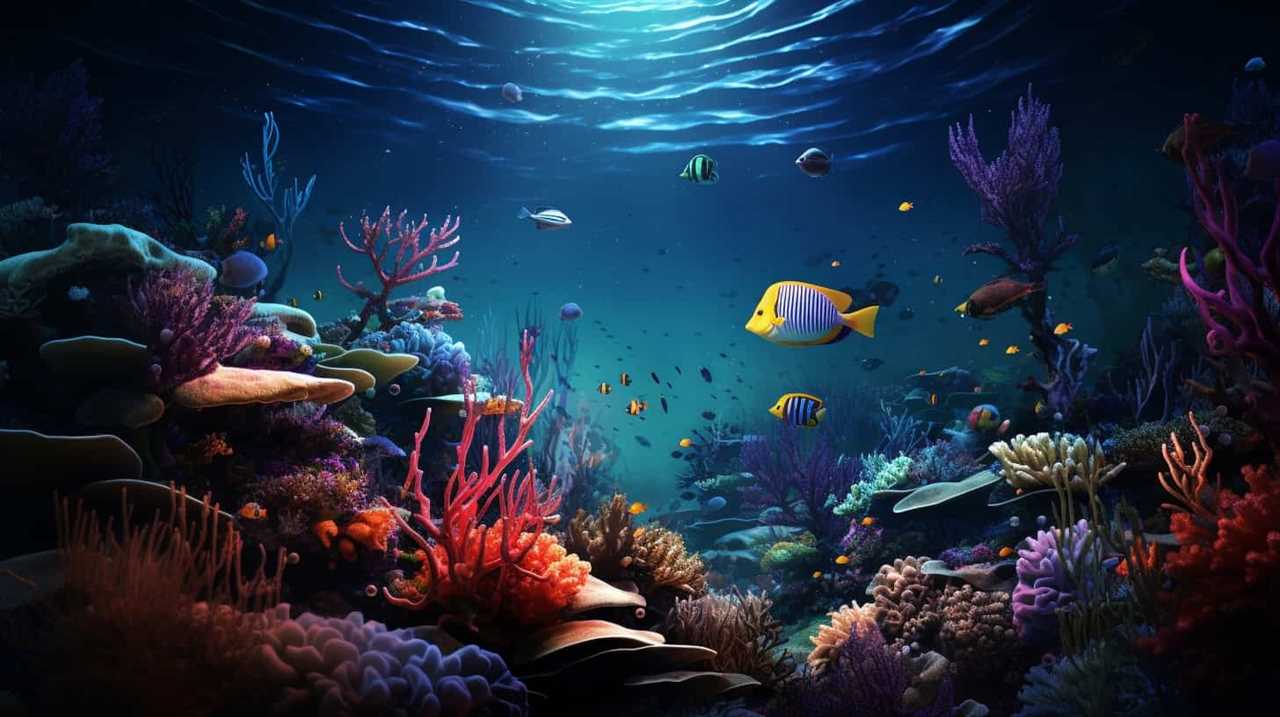Welcome, fellow adventurers, to the captivating world of marine life conversations: a thorough exploration of underwater acoustics.
Prepare to be amazed as we unravel the hidden language of the deep, where marine creatures communicate through a symphony of sound.
Together, we will delve into the science behind these mesmerizing oceanic melodies, gaining a profound understanding of the intricate acoustic signals that shape their watery world.
However, we must also confront the sobering reality of human impact on this delicate communication network.

Let us embark on this journey of discovery, seeking mastery over the mysteries of marine life’s secret conversations.
Key Takeaways
- Underwater acoustics is important for effective communication and navigation for marine organisms.
- Marine life communicates through vocalizations, which convey messages and have unique characteristics for each species.
- Studying ocean sounds provides insights into communication systems of marine animals and helps in monitoring and studying the underwater environment.
- Human activities, such as overfishing and noise pollution, can disrupt marine communication, leading to negative impacts on marine life and ecosystems.
The Importance of Underwater Acoustics
The importance of underwater acoustics can be understood through its role in facilitating effective communication and navigation for marine organisms. Underwater acoustics plays a crucial role in marine conservation by providing valuable insights into the behavior and distribution of marine species.
By studying the acoustic signals produced by different organisms, scientists can gather information about their population size, movement patterns, and even reproductive behavior. Additionally, advancements in underwater acoustic technology have revolutionized our understanding of the underwater world.
Sophisticated hydrophone arrays and underwater listening devices enable researchers to monitor marine ecosystems, detect the presence of endangered species, and assess the impact of human activities on marine life. These technological advancements haven’t only enhanced our scientific knowledge but also contributed to the development of effective conservation strategies.

Understanding the importance of underwater acoustics sets the stage for exploring how marine life communicates underwater.
How Marine Life Communicates Underwater
Marine organisms use intricate sound patterns to communicate underwater. This ability to communicate plays a vital role in their survival and reproduction.
Here are some key points about how marine life communicates underwater:
-
Evolutionary Adaptations: Over millions of years, marine organisms have developed specialized structures, such as swim bladders, to produce and receive sound. These adaptations allow them to effectively communicate in their underwater environment.

-
Role of Vocalizations: Marine organisms use vocalizations to convey various messages, including mating calls, territorial disputes, and warnings of danger. These vocalizations can be complex and can vary greatly between species.
-
Species-Specific Signals: Each species has its own unique set of vocalizations, allowing them to communicate with their own kind while avoiding confusion with other species.
-
Long-Distance Communication: Underwater sound travels much faster and farther than in air, allowing marine organisms to communicate over long distances, even in the vastness of the ocean.
-
Environmental Factors: Environmental factors, such as water temperature, depth, and ambient noise, can influence the effectiveness of underwater communication.

Understanding how marine life communicates underwater provides valuable insights into their behavior and helps us appreciate the remarkable adaptations they’ve developed.
The Science Behind Ocean Sounds
Now let’s delve into the fascinating world of underwater acoustics and explore the science behind the captivating sounds of the ocean.
Underwater sound propagation is a complex phenomenon that has been a subject of extensive marine bioacoustics research. Sound travels differently in water compared to air due to the differences in density and compressibility. The ocean serves as an excellent medium for sound transmission, allowing it to travel over long distances.
Understanding the science behind ocean sounds involves studying how sound waves propagate through the water, interact with different substances and marine life, and ultimately reach our ears. By unraveling the intricacies of underwater acoustics, scientists can gain insights into the communication systems of marine animals, the effects of human-generated noise on marine ecosystems, and can even use underwater sounds as a tool for monitoring and studying the underwater environment.

Now, let’s move on to the next section and explore the fascinating realm of understanding underwater acoustic signals.
Understanding Underwater Acoustic Signals
Let’s delve into the intricacies of understanding underwater acoustic signals. When it comes to underwater sound production, marine animals utilize various mechanisms to communicate and navigate their environment. To comprehend these signals, scientists employ acoustic monitoring techniques, which involve the use of hydrophones to capture and analyze underwater sounds.
Here are five key aspects to consider when studying underwater acoustic signals:
- Signal frequency: Different species produce sounds at specific frequencies, allowing for species identification and communication analysis.
- Sound propagation: Understanding how sound waves travel underwater is crucial for interpreting acoustic signals accurately.
- Signal structure: Analyzing the temporal structure of signals helps in deciphering their meaning and purpose.
- Ambient noise: Background noise, such as natural sounds and human activities, can interfere with the detection and interpretation of acoustic signals.
- Bioacoustic databases: Utilizing comprehensive databases of underwater sounds aids in the identification and classification of different species’ vocalizations.
Understanding underwater acoustic signals is essential as it provides insights into the complex communication systems of marine life.

Now, let’s explore the impacts of human activities on marine communication.
Impacts of Human Activities on Marine Communication
Continuing our exploration of underwater acoustic signals, we must now consider the impacts of human activities on marine communication. Two major factors affecting marine communication are overfishing effects and noise pollution. Overfishing disrupts the balance of marine ecosystems, leading to a decline in the abundance and diversity of marine species. This can directly affect the acoustic signals used by marine organisms for communication. Additionally, noise pollution caused by human activities such as shipping, construction, and sonar systems can have detrimental effects on marine communication. Excessive noise can interfere with the ability of marine organisms to detect and interpret acoustic signals, leading to communication breakdowns and reduced reproductive success. To better understand the effects of these activities, let’s examine the table below:
| Human Activity | Impact on Marine Communication |
|---|---|
| Overfishing effects | Decline in species diversity |
| Noise pollution | Interference with acoustic signals |
Understanding the impacts of human activities on marine communication is crucial for developing effective conservation strategies and minimizing our negative impact on these delicate ecosystems.
Frequently Asked Questions
How Do Marine Animals Use Underwater Acoustics to Navigate in the Ocean?
Marine animals use underwater acoustics to navigate in the ocean by communicating with each other through sound. The evolution of underwater acoustics has enabled these creatures to develop sophisticated ways of finding their way in the vast underwater environment.

Can Underwater Acoustics Be Used to Track the Movement Patterns of Marine Species?
Yes, underwater acoustics can be used to track the movement patterns of marine species. By analyzing the sounds they produce and the way sound travels underwater, we can gain valuable insights into their behavior and migration patterns.
What Are the Potential Risks and Challenges Associated With Underwater Noise Pollution?
The potential risks and challenges associated with underwater noise pollution are significant. They include disruption of marine species’ communication, migration patterns, and feeding behavior. Mitigating these challenges requires careful monitoring and regulation of human activities in the ocean.
Are There Any Regulations or Guidelines in Place to Mitigate the Negative Impact of Human Activities on Marine Communication?
There are regulations and guidelines in place to mitigate the negative impact of human activities on marine communication. These measures aim to protect marine life and ensure that underwater noise pollution is kept at a minimum.
How Do Researchers Study Underwater Acoustics and Marine Communication in the Field?
To study underwater acoustics and marine communication in the field, researchers use advanced underwater acoustic technology and various research methods. These methods allow us to gather precise data and gain valuable insights into the complex world of marine acoustics.

Conclusion
In conclusion, studying underwater acoustics provides valuable insights into how marine life communicates and interacts in their environment. By understanding the science behind ocean sounds and the signals they produce, we can better appreciate the intricacies of marine communication.
However, it’s crucial to consider the impacts of human activities on this delicate ecosystem. How can we ensure the preservation of marine communication for future generations?










